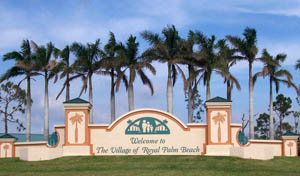The Royal Palm Beach Village Council gave preliminary approval last week to an ordinance that would more strictly regulate political signs on village and private property.
At the Dec. 5 council meeting, Planning & Zoning Director Bradford O’Brien said the ordinance would amend the village’s sign code to allow campaign signs on village-owned property at specific locations approved by the council, rather than anywhere along public rights of way.
Except for village-owned property, campaign signs could be displayed in any zoning district not more than 30 days prior to an election.
For village-owned property, political campaign signs could be displayed not more than 14 days before an election and only at locations designated by the village.
Under the proposed ordinance, political campaign signs displayed on village-owned property would have been limited to no more than 4 feet wide by 4 feet high for no more than 8 square feet, which the council later changed to one standard yard sign size for public and private property.
The display would be limited to two signs per candidate, ballot item or referendum question on each side. The signs may be placed where they are visible to passing traffic but do not create traffic or pedestrian hazards, and stakes may not penetrate the ground more than 12 inches.
The locations include Crestwood Blvd. and Folsom Road, Okeechobee Blvd. and Wildcat Way, the northwest corner of State Road 7 and Belvedere Road, the northwest corner of Royal Palm Beach and Southern boulevards, and Okeechobee Blvd. near the message board on the Village Hall campus.
Mayor Matty Mattioli questioned changing the rules that have been in place as long as he has lived in the community. “They were 10 square feet as long as I have been here, with no problem,” Mattioli said. “Why are we getting into this now?”
Mattioli also questioned having different allowable sign sizes for public and private property.
Councilman Richard Valuntas said he thought village staff had done a good job simplifying the ordinance for people who are running for election by trying to strike a balance on the size of the signs.
“This is not just for municipal elections,” Valuntas said. “This is for all elections. Because it’s going to be in a limited space, you don’t want bigger signs.”
Village Manager Ray Liggins said that because of the limited space, staff believed 10 square feet and 6 feet high would be too large. “That’s big for these areas,” he said. “You’ve got to look at these areas that we’re talking about.”
Councilman Fred Pinto asked whether the ordinance was different from those of other municipalities, and Village Attorney Jennifer Ashton said Wellington has an ordinance similar to the one proposed.
“Wellington has been successful with this for a few years,” she said, pointing out that the council can change the locations by resolution if one is not working or if council members would like to add other locations. “The nice thing about these locations is that they are considered designated public areas. Under case law, you can move them, change them [or] eliminate them.”
Councilman David Swift said that as a challenger in the last election, he saw instances when candidates who were not connected with large landowners had difficulty finding places to put their campaign signs.
“I thought it would be time to identify some place, some public property where they could do that,” Swift said.
He also pointed out that the village would be obligated to allow signs that council members don’t necessarily agree with.
Swift agreed that having two different allowable sizes would be too confusing for code enforcers, and also expressed concern that staff members were making their job harder with the regulation.
Vice Mayor Jeff Hmara said he favored a uniform sign size. He also questioned having different allowable time periods for public and private property, but was willing to discuss that later.
Pinto made a motion to approve the ordinance allowing only one standard yard signage, which carried 5-0.
In other business, the council gave preliminary approval to an ordinance that would no longer require residents to maintain sidewalks behind their homes.
O’Brien said the ordinance was drafted after some residents with homes bordering Crestwood Blvd. complained that maintaining the Crestwood sidewalk was an undue responsibility.
The ordinance states that owners of residential property will not be responsible for maintenance of sidewalks adjacent to the rear of their property on Crestwood Blvd., Southern Blvd., portions Royal Palm Beach Blvd. north of Okeechobee Blvd., Belvedere Road or State Road 7. The ordinance does not relieve those property owners from the repair or maintenance due to their actions or those of their contractors, agents or homeowners’ associations.
Pinto said he believed it was the right thing to do for residents, who had encountered difficulty with maintenance issues, including operation of pressure cleaners and conflicts with pedestrians who objected to the use of strong cleaning solutions.
Pinto asked what the estimated additional cost for maintenance would be to the village, and Liggins said about $18,000 annually.
Pinto made a motion to approve the ordinance, which carried 5-0.








